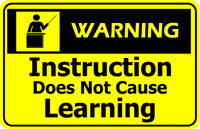A client recently relayed a comment to me from a classroom teacher. The teacher was disappointed in our e-learning unit because some students would just quickly “click through” the content, rather than spending several minutes on each screen. The instructor wanted to know if we could modify the product to force the students to spend a couple of minutes looking at each screen, before they were allowed to click “next” and proceed. My client asked how I would respond to the question.
Here’s what I said — I’m curious, how would YOU respond?
Would Forcing Longer Time On A Screen Help?
 I usually start this answer (if I think the teacher can take a little gentle ribbing) by asking if, before they hand out the textbooks, they glue down the corners of all the pages. When they say “no” I let this lead into having the group list the uses of a textbook – not just a front-to-back read, but for reference, to use for review before testing, to quote in projects, to refresh memory during open-book tests, and so forth.
I usually start this answer (if I think the teacher can take a little gentle ribbing) by asking if, before they hand out the textbooks, they glue down the corners of all the pages. When they say “no” I let this lead into having the group list the uses of a textbook – not just a front-to-back read, but for reference, to use for review before testing, to quote in projects, to refresh memory during open-book tests, and so forth.
From there, I start talking about how e-learning content can be used in many different ways by a learner. Some learners will start at the beginning, and go from front to back. Some will dip their toes in at different places. Some will scan for subjects of interest. Some will use the “search” function to find a specific subject. (I stop to point out that, as educators, we don’t get a vote in this. It’s how learners build knowledge in the world today.) So we need to understand that, and build it into our understanding of how we help them facilitate their learning.
What Has Changed In Learning, Anyway?
Back when I was in the 3rd grade, Mrs. Solem had a huge amount of control over what I learned and exactly how that happened. Today, learners expect to be able to make a lot of decisions about what and how they’re going to learn. (They make GOOD and BAD decisions, of course. That’s to be expected.) Our job as teachers and facilitators is to help guide them as they do this, to show them how to make good choices, and (ultimately) measure the outcome of their choices and achievement. The learners own their success or failure.
Technically, it’s easy to set a minimum screen time. Practically, we’ve found that learners just go browse the web or read email or paint their nails or do something else. I’ve seen no solid research that there’s a corresponding increase in learning. Much like gluing the pages down in a textbook to force students to spend more time on each one, you’re just going to frustrate the participant.
The larger question that needs to be asked here is why does the learner skip through the content, not learn, and end up with “some quiz and test scores so low”?
Given Good Content And Teaching, Why Don’t They Learn?
If we assume the content is good quality, and the teaching is good quality – why do students skip through it and fail the tests? There are enough answers there to fill a thesis dissertation, but I’ll focus here on just one. Motivation.
If we’re trying to teach a student how to write an MLA footnote, and the student sees no reason that they need to learn to do so – I could make them stay on that page for an hour and they probably won’t learn the content. (Unless I tell them there’s a test they have to pass to graduate.) Google the difference between “intrinsic” and “extrinsic” motivation for extra credit.
But if I tell the student the next screen will show them how to double their score at “Angry Birds” they will stay on that screen until they’ve squeezed every drop of knowledge out of it. Because they want that information for themselves and see the value.
So as a teacher, one of the most useful things you could possibly do is to show your students that what you’re teaching is connected to their real lives, and actually means something to them. And that’s a huge, huge job.
So — what do you think? Do you glue your virtual pages down?

{ 2 comments… read them below or add one }
We have had an issue with this and our homework or koans.
What we found is the courseware was focusing on Getting the right answer, and didn’t encourage reflection. We were pushing the students into a fixed mindset. For us asking more open ended, reflection questions helped to allow the students to take more in.
Thanks, Dick. Exactly what I try to teach the teachers here in my classes at MTC!